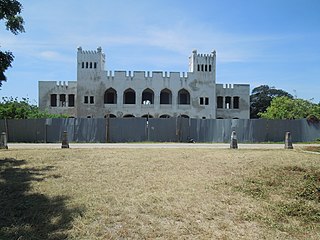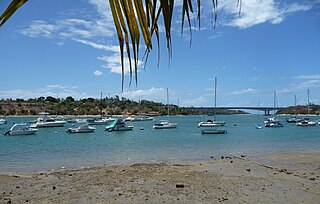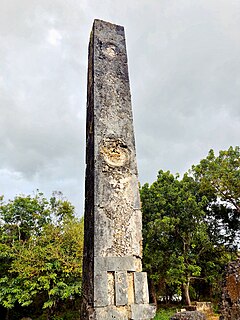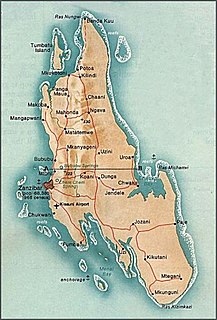
Pemba Island is a Tanzanian island forming part of the Zanzibar Archipelago, lying within the Swahili Coast in the Indian Ocean.

The ruins of Gedi are a historical and archaeological site near the Indian Ocean coast of eastern Kenya. The site is adjacent to the town of Gedi in the Kilifi District and within the Arabuko-Sokoke Forest.

Kilwa Kisiwani is an island, national historic site, and hamlet community located in the township of Kilwa Masoko, the district seat of Kilwa District in the Tanzanian region of Lindi Region in southern Tanzania. Kilwa Kisiwani is the largest of the nine hamlets in the town Kilwa Masoko and is also the least populated hamlet in the township with less than 1,000 residents. At its peak Kilwa hosted over 10,000 inhabitants in the Middle Ages. Since 1981 the entire island of Kilwa Kisiwani has been designated by UNESCO as a World Heritage Site along with the nearby ruins of Songo Mnara. Despite its significant historic reputation, Kilwa Kisiwani is still home to a small and resilient community of native residents that have inhabited the island for centuries. Kilwa Kisiwani is one the seven World Heritage Site located in Tanzania.
The Swahili people are a Bantu ethnic group inhabiting East Africa. Members of this ethnicity primarily reside on the Swahili coast, in an area encompassing the Zanzibar archipelago, littoral Kenya, the Tanzania seaboard, northern Mozambique, the Comoros Islands, and Northwest Madagascar. More recently, Swahili identity is centered around any person of African descent who speaks Swahili as their first language, is Muslim and lives in a town on the main urban centers of most of modern day Tanzania and coastal Kenya, northern Mozambique and the Comoros, through a process of swahilization.

Lamu or Lamu Town is a small town on Lamu Island, which in turn is a part of the Lamu Archipelago in Kenya. Situated 341 kilometres (212 mi) by road northeast of Mombasa that ends at Mokowe Jetty, from where the sea channel has to be crossed to reach Lamu Island. It is the headquarters of Lamu County and a UNESCO World Heritage Site.

Bagamoyo, is a coastal town founded at the end of the 18th century, though it is an extension of a much older Swahili settlement, Kaole. It was chosen as the capital of German East Africa by the German colonial administration and it became one of the most important trading ports for the Germans along the East African coast along the west of the Indian Ocean in the late 19th and early 20th century. Today, it is the capital of the Bagamoyo District in Pwani Region. In 2011, the town had 82,578 inhabitants.

Kilifi is a town on the coast of Kenya, 56 kilometres (35 mi) northeast by road of Mombasa. The town lies on the Kilifi Creek and sits on the estuary of the Goshi River. Kilifi is capital of the Kilifi County and has a population of 122,899.

The Tongoni Ruins are 15th century Swahili ruins of a mosque and forty tombs located in Tongoni ward in Tanga District inside Tanga Region of Tanzania. The area was a different place four to five centuries ago. Contrary to its almost unnoticed presence today, it was a prosperous and a respected Swahili trading centre during the 15th century. Most of the ruins are still not yet been uncovered.

Toten Island is a small uninhabited island situated north of the city of Tanga's harbour in Tanga Region, Tanzania. It is within the Tanga Bay. The island is administered by both the Tanzania Marine Parks and Reserves and the City of Tanga. The island is a historical site that contains ruins of two Medieval Swahili mosques and tombs. The current name comes from the German word for "dead bodies" alluding to the numerous graves on the island. Until 1854 Toten Island was still inhabited by people. In 1884 the remaining people moved to what is present day Tanga city.

Swahili architecture is a term used to designate a whole range of diverse building traditions practiced or once practiced along the eastern and southeastern coasts of Africa. Rather than simple derivatives of Islamic architecture from the Arabic world, Swahili stone architecture is a distinct local product as a result of evolving social and religious traditions, environmental changes, and urban development.

Swahili culture is the culture of the Swahili people inhabiting the Swahili coast. This littoral area encompasses Tanzania, Kenya, and Mozambique, as well as the adjacent islands of Zanzibar and Comoros and some parts of Malawi. They speak Swahili as their native language, which belongs to the Bantu language family. Graham Connah described Swahili culture as at least partially urban, mercantile, literate, and Islamic.

The Great Mosque of Kilwa is a congregational mosque on the island of Kilwa Kisiwani, in Tanzania. It was likely founded in the tenth century, but the two major stages of construction date to the eleventh or twelfth and thirteenth century, respectively. It is one of the earliest surviving mosques on the east African coast and is one of the first mosques built without a courtyard.

The Swahili coast is a coastal area of the Indian Ocean in Southeast Africa inhabited by the Swahili people. It includes Sofala (Mozambique), Mombasa, Gede, Pate Island, Lamu, Malindi, and Kilwa. In addition, several coastal islands are included in the Swahili coast such as Zanzibar and Comoros.

Tumbatu Island is the third-largest island making up the Zanzibar Archipelago, part of Tanzania in East Africa. The island is located off the north-west coast of Zanzibar's main island, also known as Unguja.

Mnarani is a settlement in Kenya's Kilifi County in the former Coast Province. It is located on the Kilifi Creek and just south of Kilifi town, which can be reached by crossing the Kilifi Bridge. Mnarani is located in Kilifi North sub-county.
National Historic Sites of Tanzania is an official list of places in Tanzania that have been designated as National Historic Sites as per the Ministry of Natural Resources and Tourism of Tanzania under the Antiquities Division. The list is not complete and is currently being updated.

Mkama Ndume ruins was a medieval Swahili settlement that was abandoned in the 16th Century prior to Portuguese arrival and is know for its fortification. The site is located 10 km (6.2 mi) east of the town of Chake Chake in South Pemba Region of Tanzania. The settlement was ruled by a leader named Mohammed bin Abdul Rahman, who was known for his cruelty towards his subjects thus earned his infamous nickname Mkama Ndume meaning milker of men in old Swahili. The settlement ruins bear this nickname.

Yambe Island is protected, uninhabited historic island located directly east of the city of Tanga in Tanga Region, Tanzania. It is the largest island in Tanga region. It is located entirely with the Tanga Coelacanth Marine Park (TCMP). The island is administered by the Tanzania Marine Parks and Reserves. The island is also home to Medieval Swahili ruins that have yet to be excavated.
Mushembo ruins is a Swahili historic site located in southern Tanga Region, Tanzania.The site is home to Medieval Swahili ruins that have yet to be excavated.















